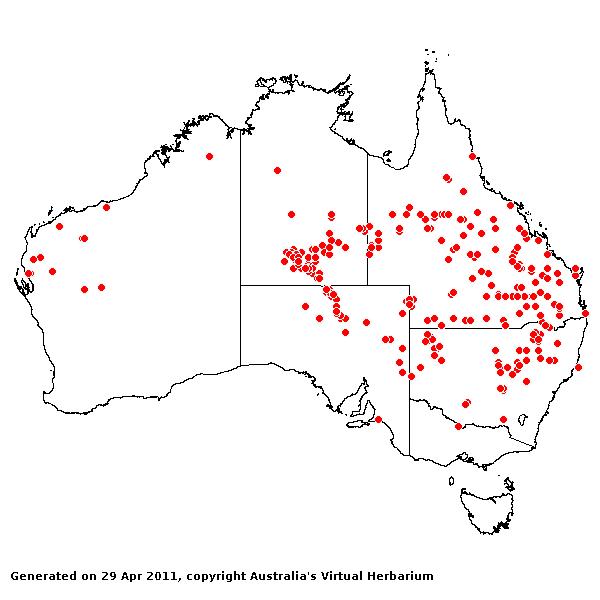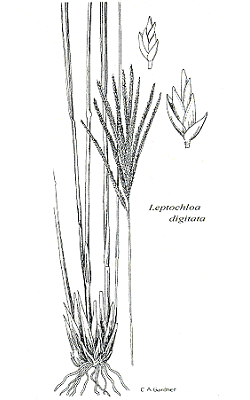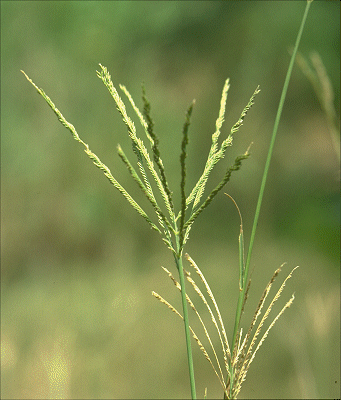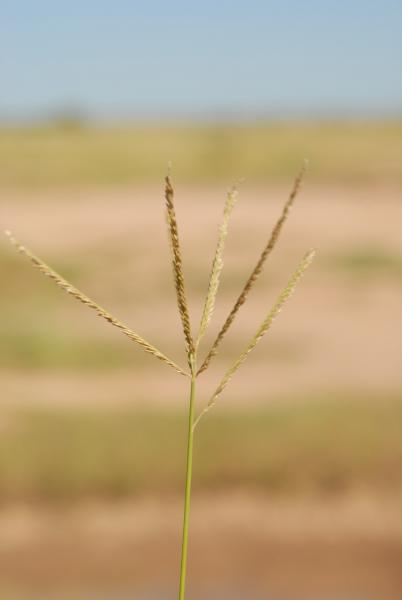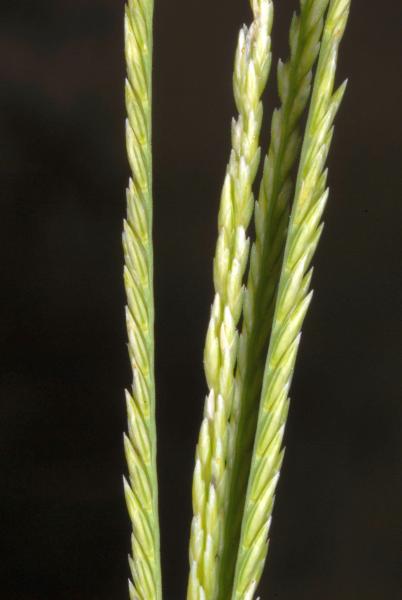Leptochloa digitata (R.Br.) Domin. Biblioth.
Bot. 85: 379 (1915).
Classification. (GPWG 2001) : Subfamily
Chloridoideae. Cynodonteae.
Basionym and/or
Replacement Name: Poa digitata
R. Br., Prodr. 181 (1810).
Type of Basionym or
Protologue Information: HT: Brown 6266, Australia:
Queensland:
Port Curtis Distr.: Broad Sound (BM; IT: BM, E, K).
Key references
(books and floras): [1878] G.Bentham, Flora Australiensis 7 (617 as Leptochloa
subdigitata), [1952] C.A.Gardner, Flora of Western Australia 1 Gramineae
(211), [1981] M.Lazarides in J.Jessop (ed)., Flora of Central Australia
(462), [2002] D.Sharp & B.K.Simon, AusGrass, Grasses of Australia,
[2006] J.Jessop, G.R.M.Dashorst, F.M.James, Grasses of South Australia
(386), [2008] S.W.L.Jacobs, R.D.B.Walley & D.J.B.Wheeler, Grasses of New
South Wales (294).
Illustrations:
[1952] C.A.Gardner, Flora of Western Australia 1 Gramineae (213,
Pl. 63), [2006] J.Jessop, G.R.M.Dashorst, F.M.James, Grasses of South
Australia (387, Fig. 320), [2008]
S.W.L.Jacobs, R.D.B.Whalley & D.J.B.Wheeler, Grasses of New South Wales,
4th edn (294).
Habit.
Perennial. Rhizomes absent or present. Culms erect, stature robust to moderate,
100–300 cm tall. Mid-culm nodes glabrous. Lateral branches sparsely branched.
Leaves cauline. Ligule an eciliate membrane or a fringed membrane, a ciliolate
membrane, 0.5–1 mm long. Leaf-blades flat, 5–22 cm long, 2–7 mm wide.
Inflorescence.
Inflorescence subdigitate, with racemose branches. Racemes 6–20, 2–13 cm long.
Central inflorescence axis 0.5–1 cm long.
Spikelets.
Spikelets sessile. Fertile spikelets many flowered, with at least 2 fertile
florets (3–7), comprising 3–7 fertile floret(s), with diminished florets at the
apex, elliptic, laterally compressed, 2.5–4(–5) mm long.
Glumes. Glumes
similar. Lower glume ovate, membranous, keeled, 1-keeled, 1 -nerved. Upper
glume ovate, 1.5–2 mm long, membranous, keeled, 1-keeled, 1 -nerved.
Florets.
Fertile lemma 1.8–2 mm long, without keel or keeled, 3 -nerved. Lemma surface
glabrous. Lemma apex muticous or mucronate. Palea 2 -nerved. Anthers 3.
Continental
Distribution: Australasia.
Australian
Distribution: Western Australia, Northern Territory, South Australia,
Queensland, New South Wales.
Western Australia: Gardner, Dampier.
Fortescue, Carnarvon. Coolgardie. Northern Territory:
Victoria River,
Central Australia North, Central Australia
South. South Australia: North-western, Lake Eyre, Eastern. Queensland:
Burke, Burnett, Cook, Darling Downs, Gregory South, Leichhardt, Maranoa,
Mitchell, Port Curtis, South Kennedy, Warrego, Wide Bay.
New South Wales: North-Western Slopes, Central-Western Slopes,
North-Western Plains, South-Western Plains, North Far Western Plains, South Far
Western Plains.
Notes.
A distinctive species with several diagnostic features including robust xerophytic
habit, cane-like smooth powdery culms, olive-green spikelets, congested
subdigitate panicle, rounded rather than keeled lemmas and flattened grain.
Glabrous on all floral and vegetative parts except for sparse hairs on the
callus and auricles.
Endemic;
widely distributed in all mainland States except Vic. Occurring chiefly in arid
and semi-arid regions, but extending into higher rainfall areas in Queensland and New
South Wales. In most parts of its distribution,
plants are associated with watercourses, floodplains and similar better-watered
sites, often forming conspicuous, bamboo-like stands.

